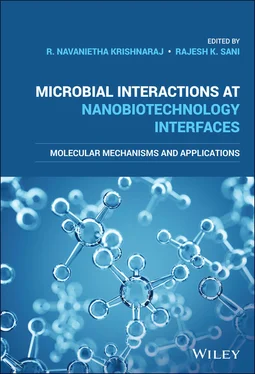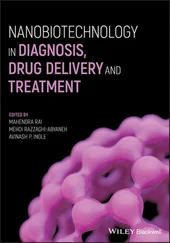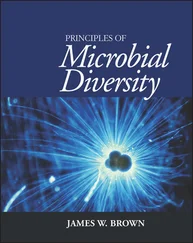Microbial Interactions at Nanobiotechnology Interfaces
Здесь есть возможность читать онлайн «Microbial Interactions at Nanobiotechnology Interfaces» — ознакомительный отрывок электронной книги совершенно бесплатно, а после прочтения отрывка купить полную версию. В некоторых случаях можно слушать аудио, скачать через торрент в формате fb2 и присутствует краткое содержание. Жанр: unrecognised, на английском языке. Описание произведения, (предисловие) а так же отзывы посетителей доступны на портале библиотеки ЛибКат.
- Название:Microbial Interactions at Nanobiotechnology Interfaces
- Автор:
- Жанр:
- Год:неизвестен
- ISBN:нет данных
- Рейтинг книги:4 / 5. Голосов: 1
-
Избранное:Добавить в избранное
- Отзывы:
-
Ваша оценка:
- 80
- 1
- 2
- 3
- 4
- 5
Microbial Interactions at Nanobiotechnology Interfaces: краткое содержание, описание и аннотация
Предлагаем к чтению аннотацию, описание, краткое содержание или предисловие (зависит от того, что написал сам автор книги «Microbial Interactions at Nanobiotechnology Interfaces»). Если вы не нашли необходимую информацию о книге — напишите в комментариях, мы постараемся отыскать её.
Microbial Interactions at Nanobiotechnology Interfaces — читать онлайн ознакомительный отрывок
Ниже представлен текст книги, разбитый по страницам. Система сохранения места последней прочитанной страницы, позволяет с удобством читать онлайн бесплатно книгу «Microbial Interactions at Nanobiotechnology Interfaces», без необходимости каждый раз заново искать на чём Вы остановились. Поставьте закладку, и сможете в любой момент перейти на страницу, на которой закончили чтение.
Интервал:
Закладка:
Raza et al. (2016) showed that spherical silver NPs of smaller size (15–50 nm) had higher antibacterial activity against E. coli and P. aeruginosa in comparison to bigger spherical NPs (30–200 nm) and triangular NMs (edge length 150 nm). This observation was in contrast with previous studies of Pal et al. (2007) and Van Dong Ha, Binh, and Kasbohm (2012), where the triangle‐shaped silver NMs exhibited better antimicrobial property than spherical NMs. The explanation of enhanced antibacterial effect of triangular silver nanostructures was based on the presence of highly reactive and dense atomic crystal facets (111). But here the XRD study revealed that the spherical silver NPs had a strong diffraction peak at 2θ 38.5° from (111) facets. This suggested that spherical NPs were made up of top basal plane with the reactive (111) crystal facets, which could have enhanced the ROS production in bacterial cell and so their antimicrobial property (Raza et al., 2016). In a recent study Cheon et al. (2019) showed a shape‐dependent antimicrobial property of Ag NPs. Antimicrobial property of differently shaped Ag NPs was studied using S. aureus, E. coli, and P. aeruginosa . The zone of inhibition studies showed that Ag spherical NP exhibited highest antibacterial property followed by Ag NM disks and triangular plate Ag NMs (Cheon et al., 2019). The difference in the antimicrobial property was attributed to the release of Ag +ions from NMs. Considering the surface area, spheres had the highest surface area (1307 ± 5 cm 2) followed by disk (1104 ± 109 cm 2) and triangular plate (1028 ± 35 cm 2). The higher the surface area the higher the release of Ag +ions, which could be the plausible reason for the highest antimicrobial property of spherical nanospheres followed by disk and triangular plate. The released Ag +ions interact with bacterial proteins or enzymes through sulfhydryl groups, thereby inactivating or destabilizing the cellular components. Ag +ions also bind to the membrane proteins that are involved in the ATP generation and ion transport across the cell membrane. Further, the released Ag +ions interact with nucleic acids and disrupt the H‐bonds of DNA strands, thereby preventing the division and growth of the bacteria. Additionally, they induce the production of ROS, which in turn oxidizes the cellular components such as proteins and DNA. Gao et al. (2013) showed that the antibacterial activity of the Ag nanospheres is higher than that of nanoplates. The results suggested that nanospheres with higher surface area might have had greater contact with bacterial surface in comparison to nanoplates (Gao et al., 2013). In another recent study, Acharya et al. (2018) compared the antibacterial property of Ag nanorods with spherical NPs against E. coli, P. aeruginosa, S. aureus, and B. subtilis . The study revealed that both nanospheres and nanorods were very effective against both the Gram‐positive and Gram‐negative bacteria. The enhanced antibacterial property of both spheres and rods has been attributed to the presence of (111) plane. In general, plane (111) possesses high atomic density, which is one of the factors that determines the antibacterial activity of the Ag NMs (Acharya et al., 2018).
In a similar study, Sharma, Agarwal, and Balani (2016) studied the effect of shapes of ZnO nanostructures on their bactericidal property. Here the author synthesized ZnO microrods and microdisks from ZnO NPs of size (<100 nm) using hydrothermal route. The antimicrobial activity of ZnO structures against Gram‐positive S. aureus and Staphylococcus epidermidis revealed that minimum inhibitory concentration (MIC) of all the three materials was within 0.5 μg/ml, whereas the same for Gram‐negative bacteria E. coli was in the range of 70–76 μg/ml. The mechanism of action involved the production of H 2O 2, Zn 2+ions release, and the presence of surface oxygen vacancies. In general, the release of metal ion from a material depends on the plane area of the material. Notably, the ZnO microdisks had the highest basal plane area, which led to the highest release of Zn 2+ions from the surface (75.3 ± 14.6 μg/l in MilliQ water and 631.3 ± 17.3 μg/l in LB medium) in 48 hours at 37 °C. Hence the mechanism of action of ZnO microdisks and microrods were suggested to be through release of Zn 2+ions whereas the release of H 2O 2and Zn 2+along with cellular internalization was in case of ZnO particles (Sharma et al., 2016). Cha et al. (2015) studied the effect of ZnO NMs over a model enzyme β‐galactosidase (GAL), which can be extrapolated to similar bacterial enzymes. The inhibition mechanisms of three different shapes of ZnO NMs – pyramid, plates, and spheres – were studied using: Michaelis Menten, Lineweaver Burk, and Eadie–Hofstee kinetics models. Among the three different shapes, nanoplates exhibited competitive inhibition over GAL whereas the ZnO NMs of pyramid shape exhibited noncompetitive mechanism. Such variation in the inhibitory effects has been explained by the ability of particular shapes to partially enter the grooves of the active site and inhibit the catalytic reaction by interfering in the reconfiguration of enzyme during substrate binding (Cha et al., 2015). The sharp edges and the apexes of nanopyramids could have been a better geometrical match to the surface of enzyme. These factors further determine the association of proteins with NMs and hence their inhibition mechanism. This clearly showed that the antimicrobial property and mechanism of action strongly depend on the shape of NMs. However, the antimicrobial property of different NMs or same NMs synthesized by different methods could not be generalized on a particular shape. Since, along with shape, the organization of active facets present in the particular NM also plays a crucial role in determining its antimicrobial property. Hence, along with shape other sub‐parameters such as facets organization and crystallinity should also be taken into account. Apart from size and shape, surface chemistry is the third most important factor that dictates the antimicrobial property, which we discuss briefly in the following section.
1.13 Effects of Functionalization on the Antimicrobial Property of Nanomaterials
Although several antimicrobial agents have been developed so far, they are still not able to meet the required therapeutic index. Even though NMs are well‐known for their renowned antibacterial activities, their application is still limited due to their certain nonspecific toxicity. In order to improve antimicrobial therapeutic index and reduce the nonspecific toxicity, biofunctionalization or chemical modification of NPs with bioactive molecules has emerged as a plausible and promising solution. The selection of a NM along with a rational biomolecule is likely to improve the applicability of the composite NM.
Several techniques have been employed to functionalize NMs such as covalent bonding (Veerapandian et al., 2010), non‐covalent bonding (Knopp, Tang, & Niessner, 2009), simple coating or deposition (Bunker et al., 2007), stober technique (Luckarift et al., 2007), coupling reaction‐assisted immobilization (Wang et al., 2004), reverse micelle and sol–gel technique (Yang et al., 2004). Photo‐Fenton oxidation, radiofrequency plasma, and vacuum‐UV radiation methods have been employed for click chemistry (Mazille et al., 2010). Protein and peptides, especially those with cationic nature, have been found to be toxic against many drug‐resistant microbes. The antimicrobial property of these proteins or peptides depends on the ability to form α‐helical or β‐sheets or α‐helical bundles because of the interaction with anionic bacterial cell wall and self‐association in solution state (Fernandez‐Lopez et al., 2001; Oren et al., 2002). In an earlier study, the antibacterial activity of hen egg lysozyme‐conjugated polystyrene latex NPs against Micrococcus lysodeikticus was studied. It was observed from the study that antimicrobial property of cationic NP‐conjugated enzyme was twice that of free enzyme (Satishkumar & Vertegel, 2008). Similar to proteins, carbohydrate also enhances the antimicrobial property of NMs. Veerapandian et al. (2010) reported that the glucosamine (amino sugar) functionalization of silver NPs improved the antimicrobial property against eight Gram‐positive and Gram‐negative bacteria. The functionalization of glucosamine over silver NPs enhanced the interaction and penetration of NPs into bacterial cell, which improved the antibacterial activity of glucosamine‐functionalized silver NPs (Veerapandian et al., 2010). Next to proteins and carbohydrates, lipids also possess antimicrobial property and they are part of innate immune system. The common antimicrobial lipids found in skin cells of human involve sphingosine, dihydro‐sphingosine, 6‐hydrosphingosine, sapienic– acid, and lauric acid (Drake et al., 2008). A study reported that oleic acid‐stabilized silver NPs exhibited highest antimicrobial property against E. coli and S. aureus . It was observed that the hybrid material produced a quick response over E. coli than S. aureus . The stabilization of oleic acid improved the permeability of the NP inside the bacterial cell, which inhibited or altered the cellular transport across the bacterial cell and resulted in bacterial cell death (Le et al., 2010). Apart from other biomolecules like proteins/peptides, carbohydrates, lipids, and DNA, the NMs have been functionalized with antibiotics to improve their antibacterial effect through synergistic effect. It was reported earlier that the introduction of antibiotics such as kanamycin, erythromycin, ampicillin, and chloramphenicol along with silver NPs has enhanced the antibacterial property of silver NPs (Fayaz et al., 2010). The ampicillin silver NP complex has shown the highest antimicrobial effect over other complexes. Here, the strong van der Waals attraction force caused the interaction of NP with the bacterial cell surface. This interaction led to the lysis of cell wall and subsequent penetration of NP into cell where it intervened with the DNA unwinding and effected in the death of bacterial cell (Fayaz et al., 2010). In another study, Jaiswal and Mishra (2018) showed that the functionalization of silver NPs with curcumin improved the antimicrobial properties and also reduced the cytotoxicity of the silver NPs against human keratinocytes (Jaiswal & Mishra, 2018). However, in recent years a lot of work is going on with functionalization of NMs and the basic understanding of the interaction of the bacterial system with functionalized NPs. Better understanding of mechanism of functionalized NMs along with suitable nano‐bio interface phenomenon will guide us to develop more standard design criteria to develop advanced materials with peculiar and desired properties.
Читать дальшеИнтервал:
Закладка:
Похожие книги на «Microbial Interactions at Nanobiotechnology Interfaces»
Представляем Вашему вниманию похожие книги на «Microbial Interactions at Nanobiotechnology Interfaces» списком для выбора. Мы отобрали схожую по названию и смыслу литературу в надежде предоставить читателям больше вариантов отыскать новые, интересные, ещё непрочитанные произведения.
Обсуждение, отзывы о книге «Microbial Interactions at Nanobiotechnology Interfaces» и просто собственные мнения читателей. Оставьте ваши комментарии, напишите, что Вы думаете о произведении, его смысле или главных героях. Укажите что конкретно понравилось, а что нет, и почему Вы так считаете.












